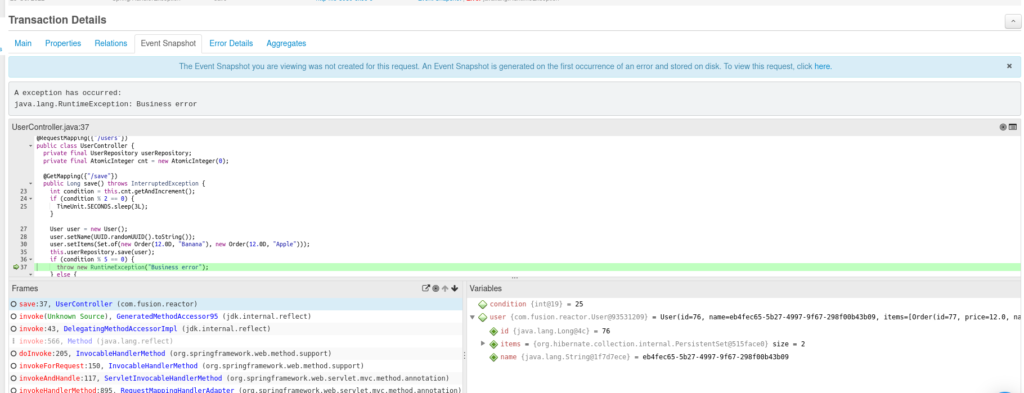The ConcurrentModificationException is a runtime exception that is thrown in Java when an operation is performed on a collection (e.g. a list, set, or map) while another operation is being performed on the same collection. This can lead to unexpected behavior and can be difficult to debug.
In this blog, we’ll discuss the causes of ConcurrentModificationException and how FusionReactor APM can help you avoid and fix it.
An example of ConcurrentModificationException in Java
import java.util.ArrayList;
import java.util.Iterator;
public class Main {
public static void main(String[] args) {
ArrayList<String> list = new ArrayList<>();
list.add("one");
list.add("two");
list.add("three");
Iterator<String> iterator = list.iterator();
while (iterator.hasNext()) {
String value = iterator.next();
if (value.equals("two")) {
list.remove(value); // throws ConcurrentModificationException
}
}
}
}
In this example, the list.remove operation is performed while the iterator is being used to traverse the list. This leads to a ConcurrentModificationException being thrown.
To avoid ConcurrentModificationException exception take the following steps
- Use a different data structure: Consider using a data structure that does not throw a ConcurrentModificationException , such as a CopyOnWriteArrayList.
- Create a copy of the collection: Create a copy of the collection before performing any operations on it. This will ensure that the original collection is not modified while you are performing other operations on it.
- Use a synchronized collection: Use a synchronized collection, such as Collections.synchronizedList, to ensure that only one operation is performed on the collection at a time.
- Use a lock: Use a lock to ensure that only one operation is performed on the collection at a time.
- Use a concurrent data structure: Use a concurrent data structure, such as a ConcurrentHashMap, that supports concurrent modification.
Note: The best approach to avoid the ConcurrentModificationException will depend on your specific use case. It is important to understand the implications of each approach and to choose the one that is most appropriate for your needs.
How to avoid ConcurrentModificationException in a multithreaded environment
Avoiding ConcurrentModificationException in multithreaded environments can be challenging, as multiple threads may attempt to access and modify the collection simultaneously.
Here are some ways to avoid ConcurrentModificationException in a multithreaded environment:
- Use a synchronized collection: You can use a synchronized collection, such as Collections.synchronzedList, to ensure that only one thread can access the collection at a time. This can help to prevent the issue.
- Use a lock: You can use a lock to ensure that only one thread can access the collection at a time. For example, you can use a Reentrantlock to synchronize access to the collection.
- Use a concurrent data structure: You can use a concurrent data structure, such as ConcurrentHashMap, that supports concurrent modification. These data structures are designed to be used in multithreaded environments and can also help to avoid ConcurrentModificationException.
- Copy the collection: You can create a copy of the collection before performing any operations on it. This will ensure that the original collection is not modified while you are performing other operations on it.
- Use the CopyOnWriteArrayList: The CopyOnWriteArrayList is a thread-safe implementation of the List interface that supports concurrent modification. This data structure is designed to be used in multithreaded environments and can help to avoid ConcurrentModificationException.
Note: The best approach to avoid ConcurrentModificationException will depend on your specific use case. It is important to understand the implications of each approach and to choose the one that is most appropriate for your needs.
Using FusionReactor APM to diagnose an ConcurrentModificationException
- Real-time Monitoring: FusionReactor APM provides real-time monitoring of your application’s performance, allowing you to identify and resolve issues like ConcurrentModificationException as soon as they occur.
- Code Level Visibility: FusionReactor APM provides code-level visibility into your application’s performance, enabling you to see exactly where the error is occurring and what code is causing it.
- Root Cause Analysis: FusionReactor APM provides detailed root cause analysis, enabling you to quickly determine the underlying cause of the error and resolve it.
- Performance Metrics: FusionReactor APM provides detailed performance metrics, enabling you to monitor your application’s performance over time and identify trends and patterns.
Fixing ConcurrentModificationException using FusionReactor APM
- Monitor your application: Use FusionReactor APM to monitor your application’s performance in real-time.
- Identify the error: When encountering an ConcurrentModificationException, use FusionReactor APM to identify the error and determine the root cause.
- Resolve the error: Once you’ve identified the root cause of the error, use the techniques outlined above to resolve the problem.
As soon as an issue occurs, FusionReactor APM allows you to identify and resolve it in real-time
FusionReactors Event SnapShot – Code-level visibility into your application’s performance enables you to identify exactly where errors occur and which code is causing them
Conclusion – Resolving ConcurrentModificationException in Java: A Guide to Understanding, Avoiding and Fixing
ConcurrentModificationException in Java can cause severe problems in your application. By using FusionReactor APM, you can avoid and fix this error quickly and effectively, ensuring that your application runs smoothly and performs optimally. So, if you haven’t already, start using FusionReactor APM today and take control of your application’s performance and stability!





